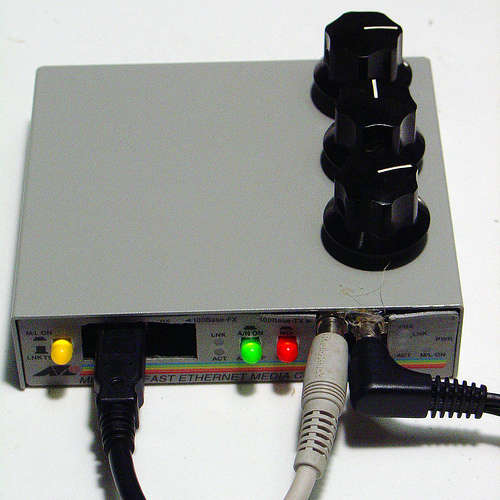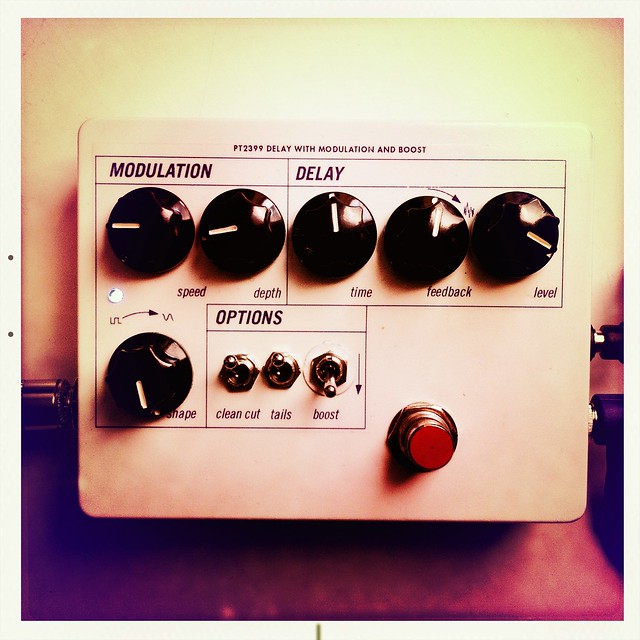The Gallolizer is a handmade multi-effects sound mangler, an array of dirty, delicious sound-destroying effects in a single handcrafted box. It’s the work of a Spanish engineering and art collective called MP19, an Arduino-loving, free software-using, open source group of artists who turn those platforms into the kind of grungy sounds that make them happy. (And that, of course, is what it’s really all about.)
But before we talk specifics, check out the video. We long ago departed the world of high-fidelity sound; this is digging your toes straight into the mud. I’ll wait.
Got it?
Good – now onto technical details. Part of what allows the various dimensions of sound in the Gallolizer’s repertoire is the sharing of schematics. Long before open source was even a term or fully-formed idea, hardware makers routinely borrowed ideas from schematics – it was hard not to – and apart from cases of gross abuse, the process was more or less a fact of life. Open source hardware and Internet sharing has since formalized that process, and made it a whole lot easier for beginners to try out making projects, thanks to ample and friendly documentation.
As a result, the Gallolizer is a window into a whole world of electronic sound ideas a tinkerer can try out. Here’s how designer Gonzalo Garcia describes the ingredients:
An Arduino Bitcrusher based on Kyle McDonald’s design (http://www.instructables.com/id/Lo-fi-Arduino-Guitar-Pedal/). We had improved the output for line level on all modes and a bit of warm in overall sound with some transistors in the output.
Ampeg Scrambler clone, based on 2n5306 darlington transistors for adding some darkness to bass and bass drums. You can transform hi-hats and snares in a more crispy sound.
Germanium fuzz is basically a NPN germanium transistors fuzzface for process sounds and add some germanium hiss.
LP Filter is based on Diego el de León’s design (http://esquemasnoise.blogspot.com/2008/12/wilson-low-pass-filter.html) for a low pass filter and based himself on a Ray Wilson’s design. Incredible resonance and a bit of analog distortion.
LoFi Delay, based on Rebote Delay from tonepad (http://www.tonepad.com/project.asp?id=51), with the infinite feedback mod and improved output for a bit of warm. We are planning to add a modulation mod to this nice delay.
Arduino Reverb based on lab3’s design (http://interface.khm.de/index.php/lab/experiments/arduino-realtime-audio-processing/), with an improved output for less noise and more warmth, based on transistors . We also add a mix control for controlling the amount of effect.

You can’t buy a Gallolizer – it’s a one-off design, unless you want to try to make them an offer. But the effects unit component will be released as a PCB and as open source hardware. It’s funny, as I had also just been looking at Kyle’s design (Kyle is such a Renaissance visual and sonic inventor, it kind of makes my head hurt), so this could be ripe for exploration. And there’s no saying this is only for those who want to become avant-garde noise artists – everyone can use a little grunge sometimes, regardless of musical idiom.
Not open source hardware, but as it happens our friend Tom Whitwell (of the sorely-missed Music Thing blog) is doing beautiful DIY work of his own based on a project from musicpcb.com. He’s also exploring techniques for housing and is making some lovely, tasteful decals, too, as you can see in the picture. I’m hoping Tom will share some of his work.
Echo Base PT2399 delay pedal on Hohner Pianet T by MusicThing
Got DIY effects projects of your own, or requests? I’ll also see if we can’t find a good beginner project for everybody. I wouldn’t mind an effects box to go with my MeeBlips.
Other wonderful projects:
http://mp19.wordpress.com/
